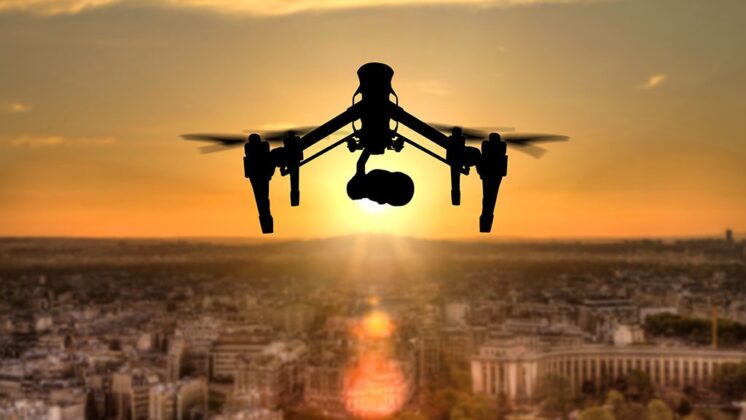What are the main drivers of the drone sector? How will the rising market impact traditional industries such as agriculture, retail, security, and even mining? Will drones be advanced enough by the 2020 Olympic Games to carry athletes onto the field?
Let’s check out a bird’s eye view of the main economic sectors transforming through drones.
Drones in Construction
Construction is currently the fastest growing sector at 239% in 2017, as well as the most significant industry with an $11 billion USD forecast for 2019. An extensive range of works falls into construction to manage workflows 24/7, including surveillance, infrastructure data collection, telecommunications, transport, inspection, maintenance, danger zone operations, surveying, and mapping. Drones at work sites increase safety, document and analyze progress, reduce overtime, and identify potential problems before they become costly.
Although the US Federal Aviation Administration dictates strict regulations on the use of professional drones, models used by construction companies have dipped below the weight threshold of 2 kilograms and travel beyond the radius of 120 meters. This conveniently lands them in the hobby-class category, which has more permissive regulations. Thanks to that, construction drones are growing in popularity so quickly that engineers have updated the classic “bird’s eye view” expression to “drone view.”

Drones in Agriculture
The market for drones in agriculture grew by 172% in 2017 and is expected to reach a value of $6 billion USD in 2019. The growth here will be driven by precision agriculture, a part of which has traditionally been carried out by satellite imaging, or by portable or mounted sensors in tractors. Drone applications will mainly be in mapping and surveying, crop dusting, irrigation management, and livestock monitoring. In fact, they provide immediate benefits in increasing yields to improve production, identifying potential crop health problems, and saving time. They are also capable of generating precise orthomosaic maps for better crop planning and land management. A study by PwC states that drones will contribute 25.4% of the added value created in agriculture.

Currently, regulations in agriculture still prevent growth of more than 7% per year. However, Gartner foresees a radical change by 2020 that will come from looser regulations and pressure from lobbies, paving the way for drones to disrupt the sector. MIT Tech Review anticipates that algorithms will soon be able to analyze agricultural data to determine when to harvest, water, or replant crops. The Moonshot Factory’s X lab, Google’s semi-secret research facility, is exploring this direction.
Drones in the Consumer Market: Logistics and Retail
Between 2016 and 2020, consumer market companies are projected to spend $17 billion USD. Competition is fierce between traditional brick and mortar companies and their digital counterparts. The former are using drones to digitize, optimizing tasks in a vertical approach, while the latter are using drones to integrate value chains horizontally in real time.
Approximately 80% of logistics companies expect to use drones for same-day deliveries. Delta Drone and the French giant GEODIS say such an automated system will be much more cost efficient in the long run.

A 2018 BI Intelligence report ranked the top five US consumer preferences for drone delivery: apparel (27%), electronics (14%), food (11%), books (11%), and medication (10%). Even before this, Amazon.com had announced its plans for Amazon Prime Air and began testing vehicles internationally at its distribution centers in the US, the UK, Austria, France, and Israel. Their operations strategy is quite ambitious: “We will deploy [drones] when and where we have the regulatory support needed to safely realize our vision. We’re excited about…one day using [this technology] to deliver packages to customers around the world in 30 minutes or less.” Experts estimate that drones will be 53% dedicated to last-mile delivery (moving goods from the distribution center to the final destination) and 37% to the linehaul (moving goods over long distances between major points).
Project Wing from Google’s X lab will begin testing deliveries of last-mile drones in Helsinki, Finland, this spring, according to TechCrunch. Customers will be able to place orders through a mobile application for products ranging from over-the-counter medications to groceries. Drones will then deliver packages weighing up to 3.3 pounds over distances of up to 6.2 miles. Deliveries will be free.
Drones in Japan: Flying Taxis in 2020
In 2018, the first taxi drone project was presented in Japan, sponsored by the Japanese government in collaboration with 19 private entities, including Uber, Boeing, Airbus, the Kitty Hawk Project, Lilium Aviation, Safran, Honeywell, Japan Airlines, All Nippon Airways, NEC, and Toyota’s CARTIVATOR. One of the project’s goals is to develop drone taxis in time for the Tokyo 2020 Olympics. SkyDrive, the current drone-like vehicle in development, would soar 10 meters (33 feet) above the ground at speeds of up to 100 km/h (62 mph). Toyota has invested about ¥ 42.5 million ($382,000 USD) in the project and contributed with the collaboration of several Toyota engineers.

Toyota plans to become the Japanese leader in drone technology. They have announced plans to invest around 1.05 trillion yen ($9.3 billion USD) on R&D. “Things will not progress if you wait and provide money only when the technology is ready,” said Toyota Chairman Takeshi Uchiyamada to the Nikkei Asian Review.
Only the beginning…
Experimental drone flights are lifting off everywhere with the support of governments, legislators, researchers, companies, and private citizens in both developed and developing nations. Once intelligent sensors, IoT, and built-in AI chips grant drones the required level of safety and security, there will be a new sight commonplace in our skies. Passengers, please head to the boarding gate. The flight to the future will be departing soon from Tokyo.



